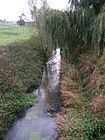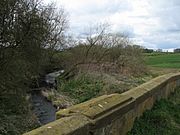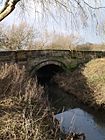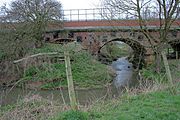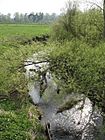River Wiske facts for kids
Quick facts for kids River Wiske |
|
|---|---|
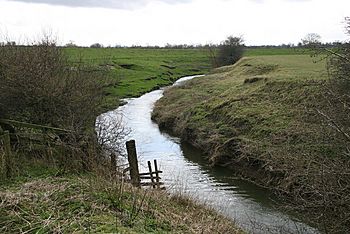
River Wiske close to its confluence with the River Swale
|
|
 |
|
| Other name(s) | Foulbroke (Foul Brook) |
| Country | England |
| Physical characteristics | |
| Main source | Confluence of Stony Lane Beck and Carr Beck nr Ingleby Arncliffe 69 metres (226 ft) 54°23′10″N 1°19′25″W / 54.38611°N 1.32361°W |
| River mouth | River Swale nr Kirby Wiske 21 metres (69 ft) 54°14′38″N 1°26′19″W / 54.24389°N 1.43861°W |
| Length | 46.9 kilometres (29.1 mi) |
| Basin features | |
| Basin size | 215.5 square kilometres (83.2 sq mi) |
The River Wiske is a river in Yorkshire, England. It flows into the River Swale. The Wiske gives its name to many villages along its path. The name Wiske comes from an Old English word wisca. This word means a water meadow, which is a grassy area often flooded by a river. The river was also sometimes called the Foulbroke.
Contents
What is the River Wiske's Path?
The River Wiske starts where two smaller streams meet. These streams are Carr Beck and Stony Lane Beck. This meeting point is south of Ingleby Arncliffe. The river then flows north, winding through the land. It passes East Rounton and turns northwest.
It then flows west past Appleton Wiske. After going under the A167 road near Great Smeaton, it turns south. The river continues mainly south towards Danby Wiske, Yafforth, and Northallerton. Finally, near Kirby Wiske, it turns southwest. Here, it joins the River Swale. The water from the Wiske eventually reaches the sea at Spurn Head. This is at the mouth of the Humber Estuary.
What is the History of the River Wiske?
In 1995 and 1996, there was a very dry period. To help, a pipeline was built. This pipeline connected the River Tees near Darlington to the Wiske near Birkby. This link was made to move water from one river system to another. It was like an "insurance policy" in case of future dry spells. Even though it was tested, the pipeline has not been used for its main purpose.
The river is looked after by the Swale and Ure Internal Drainage Board. This board helps manage water levels and prevent flooding. Before 2012, the River Wiske had its own board. But then, several smaller boards in the area joined together.
What Challenges Does the River Face?
The River Wiske has faced some challenges. These include pollution and flooding.
How Does Pollution Affect the River?
One type of pollution is high nitrogen content. This often comes from farming activities nearby. Also, extra water from the A19 road can flow into the river near its start. This water can carry pollutants.
Why Does the River Flood?
Flooding is a problem for villages along the river. This includes places like Brompton near Northallerton. It's hard to store extra water upstream when the river flows very high. This makes flooding more likely. The Environment Agency and the Yorkshire Wildlife Trust have been working to fix these issues. They are trying to improve the river's health and reduce flooding.
What is the Geology of the River Wiske Area?
The land under the River Wiske is made of different types of rock and soil. These include sandstone, conglomerate, mudstone, and siltstone. Some of these date back to the Triassic period. There are also rocks from the Mesozoic period, like the Lias group. This group includes mudstone, siltstone, limestone, and sandstone.
What Wildlife Lives Around the River Wiske?
There are special places along the river that protect nature. These are called Nature Conservation Sites. They include Middlebrough plantation, Stony Lane Pond, Pepper Arden Bottoms, and Pheasantry Wood and Fox Covert.
The river flows through farmland with hedges. There are also areas of wet woodland and grassland. In 2010, surveys found interesting animals living here.
What Animals Live in the River?
European water voles were found along the river. These small rodents are good swimmers. European otters were also seen. Otters are playful mammals that hunt in the water.
What Other Wildlife Can Be Found?
Different types of bats, like the Soprano pipistrelle and brown long-eared bat, live in the area. Birds like the kingfisher, reed bunting, and lapwing also make their homes near the river.
Places and Features Along the River Wiske
Tributaries (Smaller Streams)These are smaller streams that flow into the River Wiske:
|
Settlements (Villages and Towns)The River Wiske flows past or through these places:
|
Crossings (Bridges)Here are some of the bridges that cross the River Wiske:
|
Images for kids


